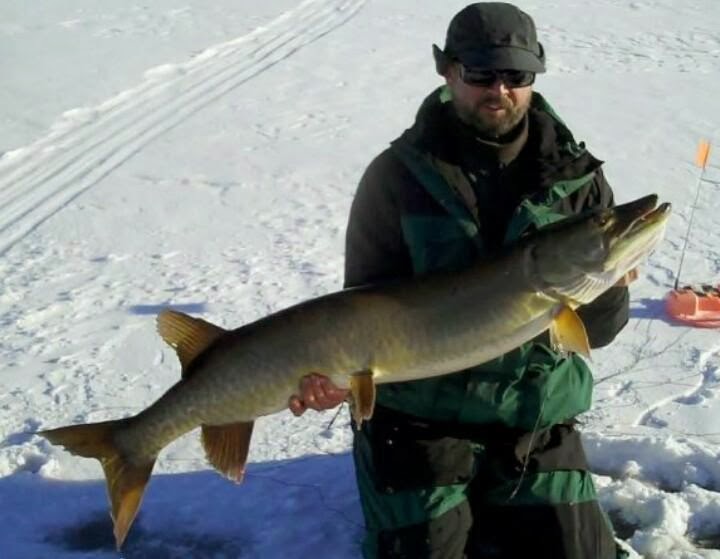Lake Hopatcong’s Enhanced Fishery is Available to All
On the border of Morris and Sussex Counties just north of Route 80, Lake Hopatcong, New Jersey’s largest lake at 2686 acres, offers the state’s most diverse fishery besides the Delaware River, a truly amazing variety of large gamefish. The Knee Deep Club first stocked hybrid striped bass in 1985. In 1996, KDC initiated muskellunge stockings. Since the early 1990’s, the state stocks juvenile hybrid stripers, walleyes, channel catfish, and true strain muskellunge and tiger muskies since 1997 in addition to its regular trout program. The Knee Deep Club stocks rainbow and brown trout and helps with other species as well. Fabulous results include muskies caught as large as 40 pounds, hybrid stripers easily reaching six or seven pounds, and four pound walleyes common. All of these species prevail—it seems every week another large musky is caught and returned alive to the lake. While legally a musky over 36 inches may be kept, strong persuasions for live release has resulted in virtually all muskies surviving after struggle.

Largemouth and smallmouth bass, abundant pickerel, yellow and white perch, crappies, and panfish are long established in the lake; yellow perch go back in time long before Europeans arrived. Fishing should remain very good at least into early July. By August, however, stratification limits fish supporting oxygen to about 15 feet and shallower. Fishing is typically tough, although a cloudy day can better produce.
Public shore fishing is limited to one or two bridges, and Hopatcong State Park, but a NJ Boater’s Safety Certificate and reasonable fee gets you a 16 foot boat with outboard at Dow’s Boat Rentals, and similar service at Lake’s End Marina. Both establishments sell live herring, great for catching hybrid stripers or walleyes.
The method is simple, but make sure to buy a map of Lake Hopatcong. Fishing Guide Maps has accurate topography, is waterproof, and about tablemat size. Structure is visible on the map to study, and even icons of fish species help you find them. Places like Nolan’s Point, Elba Point, Sharp’s Rock, Chestnut Point, and Sunrise Point are all examples of regular haunts for stripers and walleyes. If you purchase a portable graph recorder for little over a hundred dollars, a sonar device that registers bottom and fish in between, you can inform yourself more specifically about structures, and mark fish under the boat. It all depends upon whether or not you want to fish often and knowledgeably, or take it easy. Either way, get out early is my honest advice—Dow’s opens at 5:30 a.m. on weekends and lets you on the water at dawn—and try live herring on plain shank, size six hooks without weight. Yes, just let them swim on their own, cast away from the boat into the deep water of these drop offs, spinning reel bail open. By about nine a.m., unless it’s very cloudy, you can forget it. But bass and pickerel hit throughout the day.
Think weeds for largemouths and pickerel, rocks for smallmouths. Docks and other wooden structures are also particularly good for largemouths, and so are outside edges of weeds 15 to 20 feet deep. Bass travel the lake and stop in on various habitats, stages, or holding structures, whatever you prefer to call spots where as a rule they temporarily dwell. Largemouth probably follow deep weedline edges in their travels; smallmouths likely do much the same, so long as rocks are associated.
My son and I haven’t done well with pickerel through the day, except in October, although spinnerbaits and #3 or #4 Mepp’s spinners fished along weedlines work for other anglers, fished deeper in the afternoon. In our experience, we have relied on soft plastic lures, like Senko worms and Culprit twister tails to catch most of our bass, besides my son Matt and his nightcrawlers. Naturally, we catch mostly one to three pound largemouths. I could point to places and tell you how, but it’s always up to the individual to make the catch. My son and I have fished here since 2006 and plenty others still do a lot better than we have. Most musky fishing, for example, is trolling, and the rental boats aren’t geared for this. I do know of one angler who caught a small musky on a herring, fished the way I explained for stripers. It’s certainly not impossible to encounter a musky, but although my son and I have tried for them through ice, we haven’t.
My son wouldn’t feel right without his “secret weapon,” nightcrawlers. I add effectiveness for him by using a Lindy Worm Blower, available from Cabelas or Bass Pro Shops, to actually inject air into the tail. With a medium split shot 18 inches above a size six hook, the bait floats off bottom, increasing visibility—Matt always proves this is very effective for bass! He sets the hook quick so gut hooking is infrequent and the fish sure to survive after release. He also has plenty of fun with yellow perch and sunfish. Yellow perch, closely related to walleyes, sometimes reach a pound or more. Don’t be too surprised if you catch a white perch or big crappie trying for stripers and walleyes. And you never know about channel catfish—the state record, caught here, weighed 33 pounds, 3 ounces.
















































nice article, I know this river, I've been there last summer, variety of large fish. :)
ReplyDeleteThanks Richard. Yes, thanks to stocking programs, the lake has quite a variety. Back before the dam raised the water level 12 feet (it used to be sort of two lakes, connected, and the flow becomes Musconetcong River) yellow perch were native, but from what I understand, not pickerel. That's curious, since pickerel are native to NJ (but not largemouth & smallmouth bass).
ReplyDeletenice article,
ReplyDeleteThanks
Delete